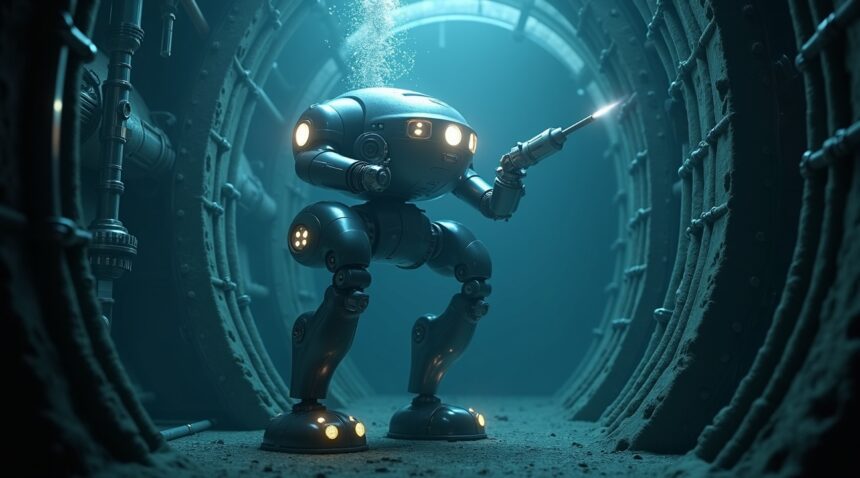Japan’s nuclear industry has depended on an extraordinary underwater robot since 1995, when Mitsubishi Heavy Industries deployed the 400-kilogram A-UT Machine to perform critical safety inspections inside pressurized water reactors.
This pioneering robot uses innovative vacuum feet technology to navigate and maintain position on reactor surfaces while conducting detailed examinations in high-radiation underwater environments where human presence would be lethal.
Key Takeaways
- The A-UT Machine weighs 400 kilograms on land but achieves near-neutral buoyancy underwater, allowing it to maneuver gracefully through reactor vessels at depths up to 20 meters.
- Its vacuum feet technology enables secure attachment to various reactor surfaces, while a seven-axis robotic arm provides ±0.1 mm positioning accuracy for precise ultrasonic and eddy-current testing.
- Remote control systems using desktop computers and joystick controllers keep human operators safely away from radiation zones while maintaining full operational control.
- The robot has completed 46 successful deployments across Japan’s nuclear facilities and earned recognition as #1 Maintenance Heritage from the Japan Society of Maintenology.
- The A-UT Machine differs from post-Fukushima cleanup robots in that it serves as a proactive maintenance tool that supports Japan’s energy security and climate goals through routine reactor inspections.
This 400-Kilogram Robot Has Been Swimming Through Japan’s Nuclear Reactors for Nearly 30 Years
Deep inside Japan’s nuclear power plants, a remarkable machine has been performing critical safety inspections for nearly three decades. Mitsubishi Heavy Industries developed the A-UT Machine in 1995, creating a specialized underwater robot that can access areas where humans simply cannot venture. This technological marvel weighs 400 kilograms on land, but the laws of physics work in its favor once submerged—achieving near-neutral buoyancy that allows it to move gracefully through reactor vessel waters.
The A-UT Machine operates exclusively within pressurized water reactor (PWR) nuclear plants across Japan, where radiation levels would prove lethal to human inspectors. I find it fascinating how this robot transforms from a hefty 400-kilogram machine into an agile underwater inspector once deployed. Its dimensions reflect careful engineering considerations: 1.8 meters in length, 1 meter in width, and 0.9 meters in height—proportions that allow it to maneuver through tight spaces within reactor vessels while maintaining stability.
Advanced Underwater Operations in Extreme Environments
This underwater inspector performs non-destructive testing in environments that challenge both equipment and engineering principles. The robot can operate at water depths reaching 20 meters, where it conducts thorough examinations of reactor vessel components. High-radiation underwater environments present unique challenges that traditional inspection methods cannot address safely or effectively.
The A-UT Machine’s vacuum feet technology represents a breakthrough in underwater robotics, allowing secure attachment to various surfaces within the reactor vessel. These specialized appendages enable the robot to maintain position against water currents and precisely position inspection equipment. I’m impressed by how Japanese engineering continues to push boundaries in safety technology.
Since 1995, this underwater robot has accumulated thousands of operational hours, providing critical data about reactor vessel integrity. The machine’s longevity demonstrates exceptional engineering and maintenance protocols that keep it functioning in one of the most challenging operational environments imaginable. Its continued service spans multiple reactor cycles, proving invaluable for maintaining Japan’s nuclear safety standards while protecting human workers from dangerous radiation exposure.
Vacuum Feet and Seven-Axis Arms Enable Precise Nuclear Component Testing
The A-UT Machine represents a groundbreaking approach to underwater reactor inspection through its innovative vacuum feet system. These specialized suction cups allow the robot to maintain stable positioning on vertical or inverted reactor surfaces, eliminating the drift issues that typically plague underwater inspection equipment. I find this adhesion capability particularly impressive because it enables the robot to perform precise measurements even on challenging reactor geometries where conventional inspection methods would fail.
Seven-Axis Precision Engineering
The robot’s seven-axis robotic arm delivers exceptional positioning accuracy of ±0.1 mm while maintaining a substantial 10 kg load capacity. This precision engineering allows technicians to conduct detailed structural assessments without compromising inspection quality. The arm’s sophisticated design accommodates the complex spatial requirements of reactor internals, reaching areas that human inspectors simply cannot access safely.
An interchangeable tool tip system enhances the robot’s versatility, enabling rapid switching between different inspection modalities. Operators can configure the machine for:
- Ultrasonic testing to detect internal flaws
- Eddy-current testing for evaluating weld lines and structural surfaces
This adaptability has proven invaluable since the robot began operations in 1995, as robotic technology continues advancing inspection methodologies.
Hybrid Navigation System
The A-UT Machine employs a sophisticated dual-mode navigation system combining thrusters for free underwater movement with wheels for surface-based locomotion. This hybrid approach allows the robot to transition seamlessly between swimming through reactor water and adhering to vessel surfaces using its vacuum feet. Thrusters provide the necessary propulsion for positioning and maneuvering in three-dimensional space, while the wheel system offers additional stability when conducting stationary inspections.
The vacuum feet technology proves particularly valuable during extended inspection sequences, as it eliminates the constant energy expenditure required to maintain position against water currents. This efficiency translates into longer operational periods and more comprehensive reactor assessments. The robot can methodically cover large surface areas while maintaining the precise positioning necessary for:
- Accurate ultrasonic measurements
- Detailed visual documentation of reactor components
Since beginning operations nearly three decades ago, this specialized inspection platform has demonstrated the critical importance of purpose-built robotics in nuclear facility maintenance. The combination of vacuum adhesion, precision manipulation, and versatile tooling creates an inspection capability that surpasses traditional methods in both safety and thoroughness.
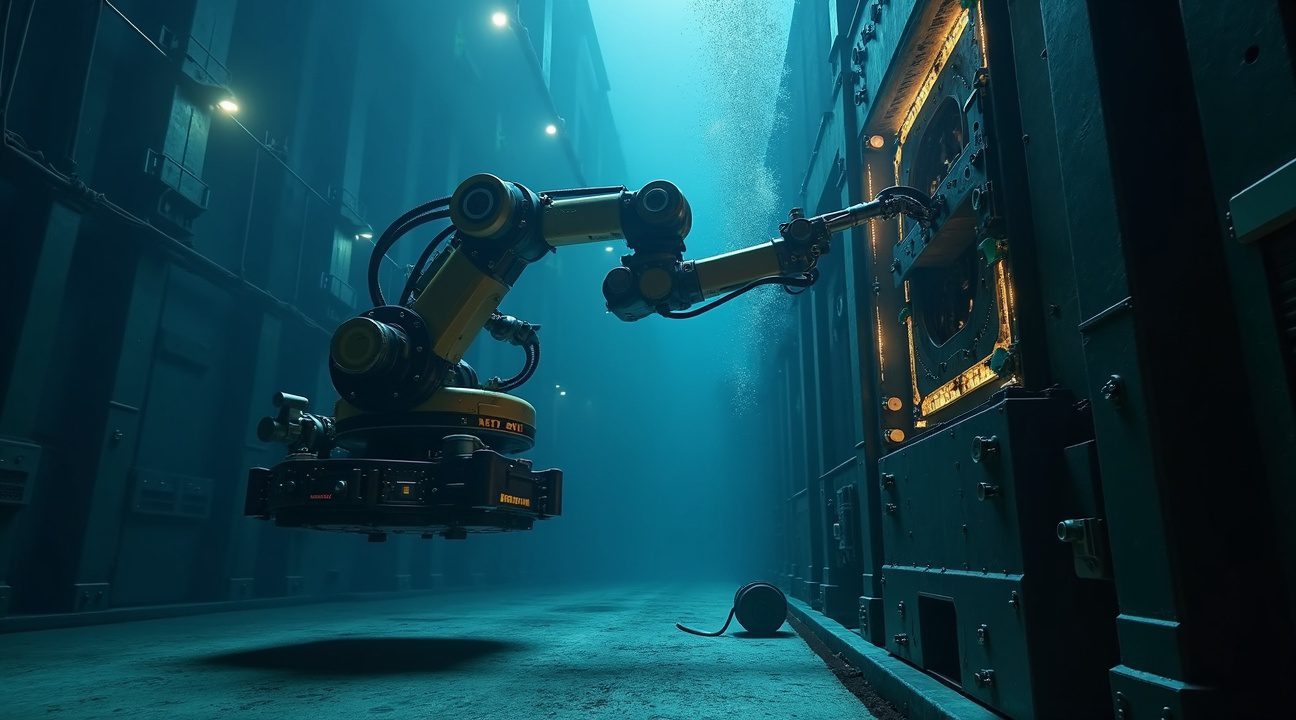
Remote Control Technology Keeps Nuclear Workers Safe from Radiation
All operations of the A-UT Machine happen through remote control systems that keep human operators safely away from dangerous radiation zones. The machine responds to commands sent through a desktop computer interface paired with a joystick controller, creating an intuitive control experience that allows technicians to perform complex underwater tasks without entering contaminated areas.
Precision Positioning Through Advanced Monitoring Systems
The A-UT Machine maintains exact positioning through sophisticated real-time tracking technology that ensures operators can execute precise movements even in challenging underwater nuclear environments. The system relies on several key components to achieve this accuracy:
- Camera systems provide continuous visual feedback of the machine’s position and surrounding environment
- Triangulation-based guidance calculates exact coordinates and movement trajectories
- Orientation sensors monitor the machine’s angle and direction in three-dimensional space
- Real-time data transmission allows operators to make instant adjustments to positioning
This combination of monitoring technologies enables the A-UT Machine to perform essential maintenance tasks that would otherwise be impossible for human workers to complete safely. The radiation levels inside these underwater reactor environments pose severe health risks, making remote operation not just convenient but absolutely necessary for worker protection.
The control interface gives operators the ability to manipulate the machine’s vacuum feet with remarkable precision, allowing it to navigate complex reactor geometries while maintaining stable contact with surfaces. Operators can adjust suction pressure, reposition the robot, and execute maintenance procedures all from a control room located at a safe distance from the radiation source.
Much like how advanced robot technology continues to evolve in various applications, the A-UT Machine represents a crucial advancement in nuclear safety technology. The machine’s ability to operate in environments where human presence would be lethal demonstrates the critical importance of remote-controlled robotics in maintaining nuclear facility safety.
The desktop computer interface displays real-time data streams from all monitoring systems, giving operators comprehensive situational awareness despite being physically separated from the work environment. This technology bridge ensures that critical maintenance work continues without compromising human safety, making the A-UT Machine an indispensable tool for nuclear facility operations since its deployment in 1995.
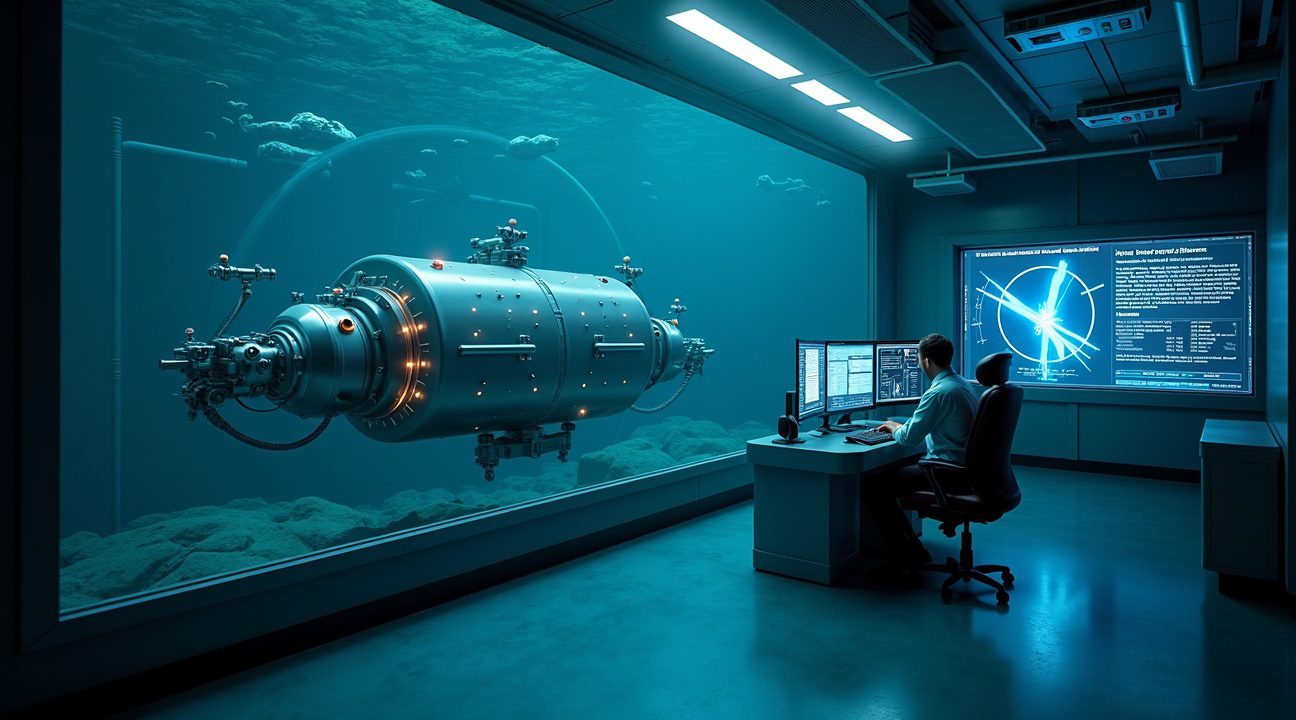
46 Successful Deployments Earn Japan’s Highest Maintenance Recognition
The A-UT Machine has established an impressive track record since its introduction in 1995, completing 46 successful deployments across pressurized water reactor installations throughout Japan. This extensive operational history demonstrates the robot’s exceptional reliability and adaptability in some of the most challenging underwater environments imaginable.
I find it remarkable that this specialized underwater robot has maintained consistent performance standards across nearly three decades of service. Each deployment represents a complex mission requiring precise navigation through reactor vessel internals, where the robot’s vacuum feet technology proves essential for maintaining stability against strong water currents and pressure variations.
Prestigious Recognition from Japan’s Engineering Community
The Japan Society of Maintenology has awarded the A-UT Machine their highest honor, certifying it as the #1 Maintenance Heritage. This recognition extends beyond mere technical achievement, acknowledging the robot’s contribution to human cultural heritage. Such prestigious recognition reflects the machine’s profound impact on nuclear maintenance practices and its role in advancing underwater robotics technology.
The certification process evaluates multiple criteria including:
- Operational reliability
- Technological innovation
- Cultural significance
Japan’s engineering community rarely bestows such recognition, making this achievement particularly noteworthy. The Society specifically highlighted how the robot has transformed maintenance approaches within the nuclear industry.
This recognition also underscores the machine’s contribution to preserving Japan’s nuclear infrastructure. Each successful deployment has helped maintain reactor safety standards while reducing human exposure to radiation. The robot’s ability to perform detailed inspections and maintenance tasks in hazardous underwater environments has proven invaluable for plant operators across the country.
The A-UT Machine’s nearly three decades of service represents a cornerstone achievement in nuclear maintenance technology. Its consistent performance across 46 deployments has built confidence among reactor operators and regulatory bodies alike. The robot’s track record includes successful operations in various reactor designs and configurations, demonstrating its versatility and robust engineering.
Plant operators consistently report that the machine’s vacuum feet technology provides superior stability compared to alternative inspection methods. This stability enables precise positioning for detailed component examinations and maintenance procedures that would otherwise require extensive scaffolding or specialized access equipment in traditional dry maintenance scenarios.
The robot’s operational history includes successful missions during both routine maintenance windows and emergency response situations. This flexibility has made it an indispensable tool for Japan’s nuclear fleet, particularly as aging infrastructure requires more frequent and detailed inspections.
Each deployment has contributed valuable operational data that continues to refine the robot’s capabilities and procedures. Engineers have documented:
- Performance metrics
- Maintenance requirements
- Operational lessons learned
This comprehensive database now serves as a foundation for training new operators and developing enhanced underwater robotics systems.
The Japan Society of Maintenology’s recognition also acknowledges the human expertise required to operate such sophisticated equipment. The robot’s success depends on skilled technicians who have developed specialized knowledge over decades of operation. This human-machine partnership represents a unique cultural achievement in Japan’s technological landscape.
Looking at the broader implications, the A-UT Machine’s success has influenced international nuclear maintenance practices. Other countries have studied Japan’s approach to underwater robotics, particularly the innovative vacuum feet design that enables stable operation in challenging reactor environments.
The machine’s contribution to Japanese engineering excellence extends beyond nuclear applications. Its development has advanced underwater robotics technology across multiple industries, from marine research to offshore infrastructure maintenance.
Critical Role in Japan’s Energy Security and Climate Response
The A-UT Machine stands as a cornerstone technology in Japan’s nuclear safety infrastructure, addressing fundamental challenges that have shaped the nation’s energy strategy for nearly three decades. This specialized underwater robot serves as Japan’s primary solution for conducting comprehensive inspections in high-radiation reactor environments where human intervention would pose unacceptable risks.
Japan’s nuclear facilities face unique operational demands, particularly in maintaining reactor safety while ensuring continuous power generation. The A-UT Machine enables plant operators to conduct thorough underwater inspections without exposing maintenance crews to dangerous radiation levels. This capability proves essential for identifying potential structural issues, corrosion patterns, and component wear that could compromise reactor safety or efficiency.
The automation provided by this technology allows nuclear facilities to implement more frequent inspection schedules than traditional methods would permit. Instead of limiting examinations to scheduled outages when radiation levels decrease, operators can deploy the robot during various operational phases. This enhanced monitoring capability directly supports Japan’s commitment to maintaining the highest safety standards across its nuclear fleet.
Supporting Japan’s Climate and Energy Goals
Japan’s energy security strategy increasingly depends on nuclear power as a low-carbon baseload generation source. The A-UT Machine plays a crucial role in supporting this strategic shift by ensuring reliable reactor operations. Several key benefits demonstrate its importance:
- Enhanced inspection frequency reduces the likelihood of unplanned outages that could strain the electrical grid
- Detailed underwater assessments help extend reactor operational lifespans through proactive maintenance
- Reduced maintenance-related downtime keeps nuclear plants available when renewable energy sources experience intermittency
- Comprehensive safety monitoring builds public confidence in nuclear power operations
The robot’s vacuum-assisted mobility system allows it to access confined underwater spaces within reactor vessels that would otherwise remain uninspected for extended periods. This access capability proves particularly valuable for examining reactor pressure vessel welds, cooling system components, and structural supports that experience continuous stress during operations.
Climate change mitigation efforts in Japan rely heavily on maintaining nuclear capacity while reducing fossil fuel dependence. The A-UT Machine supports these objectives by enabling nuclear plants to operate more reliably and safely. When nuclear facilities can maintain higher capacity factors through improved maintenance and inspection protocols, Japan reduces its reliance on coal and natural gas power generation.
The technology also addresses workforce challenges facing Japan’s nuclear industry. Advanced robotics like the A-UT Machine help compensate for skilled technician shortages while providing more consistent inspection quality than human-dependent methods. This automation ensures that safety standards remain high even as the nuclear workforce ages and fewer workers enter the field.
Energy security considerations make the A-UT Machine’s contributions particularly significant. Japan imports nearly all its fossil fuel requirements, making domestic nuclear capacity essential for reducing foreign energy dependence. The robot’s ability to maintain reactor safety and extend operational lifespans directly supports Japan’s goals of achieving greater energy independence while meeting carbon reduction targets.
The continuous operation capability provided by robotic inspection systems allows nuclear plants to contribute more effectively to grid stability. As Japan integrates increasing amounts of variable renewable energy, reliable baseload nuclear capacity becomes more valuable. The A-UT Machine helps ensure that nuclear facilities can provide this stability by maintaining high availability rates through superior maintenance and inspection protocols.
Modern reactor operations demand increasingly sophisticated monitoring approaches to balance safety requirements with operational efficiency. The A-UT Machine addresses this challenge by providing detailed underwater assessments that inform both immediate maintenance decisions and long-term asset management strategies. This comprehensive approach helps nuclear operators optimize their facilities’ contributions to Japan’s clean energy transition while maintaining the safety standards essential for public acceptance of nuclear power.
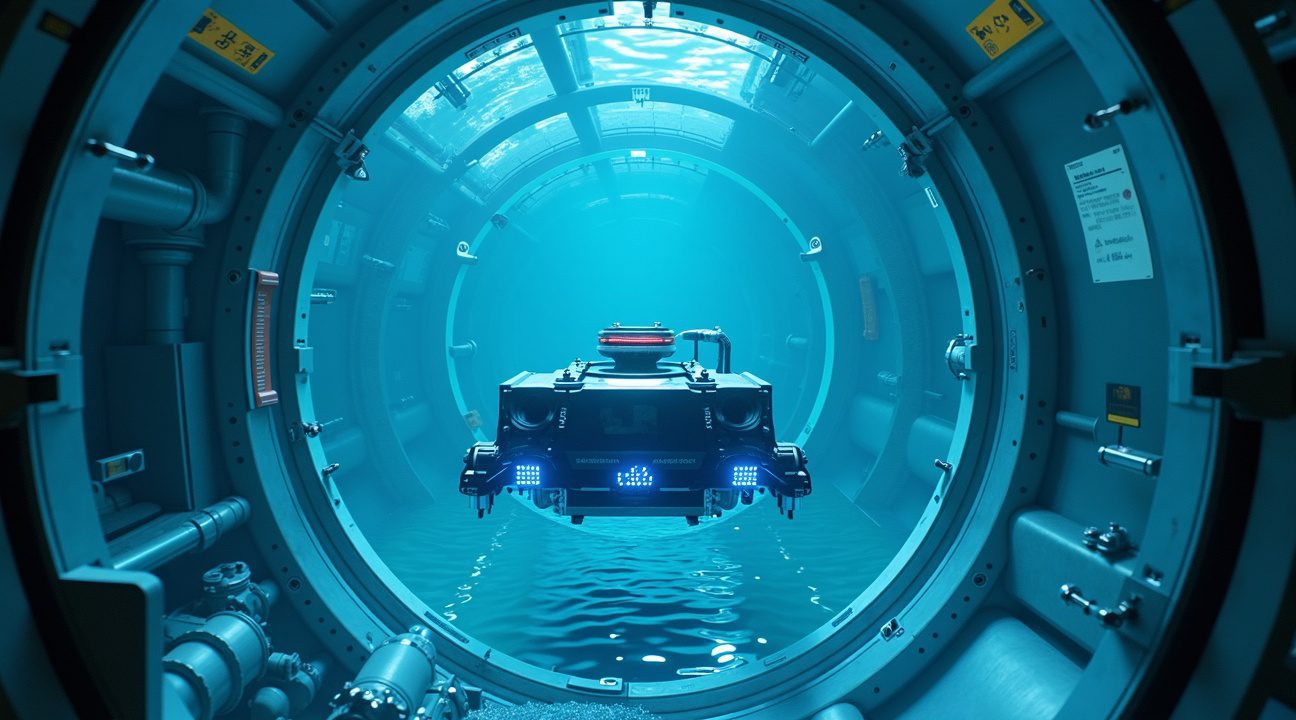
How Japan’s Nuclear Inspection Robot Differs from Post-Fukushima Cleanup Bots
The A-UT Machine stands apart from the fleet of specialized robots that emerged after the Fukushima disaster. While newer models like Toshiba’s ‘Mini Manbou’ were developed specifically for post-accident reactor investigations, this veteran underwater robot has been conducting routine inspections since 1995, long before such catastrophic events shaped the industry’s approach to robotic assistance.
Purpose and Operational Context
Post-Fukushima robots serve a fundamentally different mission compared to the A-UT Machine’s original design. These newer units focus on:
- Damage assessment
- Debris removal
- Radiation monitoring in compromised reactor environments
In contrast, the A-UT Machine was engineered for preventive maintenance and routine inspection of normally operating pressurized water reactors. This distinction makes it a proactive maintenance tool rather than an emergency response solution, much like how advanced robots have evolved to handle increasingly complex tasks.
The operational environments also differ significantly. While Fukushima cleanup bots must navigate damaged structures and debris fields, the A-UT Machine operates in controlled underwater environments within functioning reactor systems. This stable operational context allows for more predictable mission parameters and longer-term deployment strategies.
Design and Capabilities
Size and sophistication set the A-UT Machine apart from its post-disaster counterparts. Where cleanup robots prioritize compact designs for accessing tight spaces and navigating rubble, this inspection veteran features:
- Substantial dimensions
- Advanced manipulator systems
- Surface adhesion technology using vacuum feet for secure positioning
This represents a more mature approach to underwater reactor work compared to the often disposable nature of emergency response robots.
The advanced manipulators on the A-UT Machine reflect decades of refinement for precision inspection tasks. These systems enable detailed examination of reactor components during routine maintenance windows, providing data that helps prevent accidents rather than responding to them. Post-Fukushima bots, while impressive in their own right, often sacrifice sophisticated manipulation for radiation resistance and expendability.
The A-UT Machine’s extensive operational history demonstrates a sustained commitment to proactive nuclear safety through regular inspection protocols. This experience base gives Japanese engineers valuable insights into long-term robotic operation in nuclear environments, knowledge that proves invaluable when developing both routine maintenance systems and emergency response capabilities. The robot’s longevity speaks to the effectiveness of its design philosophy, which prioritizes durability and repeated use over the single-mission focus of many post-accident cleanup systems.
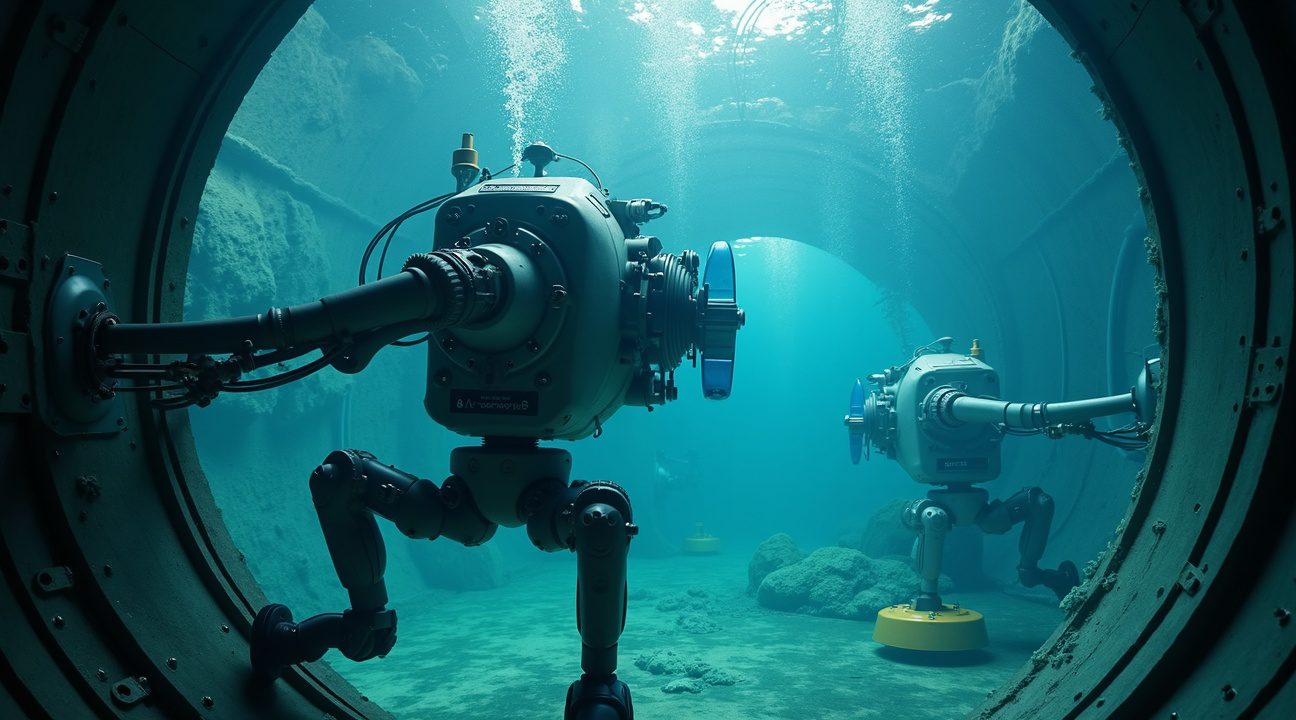
Sources:
Robotics and Automation News: “Mitsubishi develops underwater robot for inspecting Japanese nuclear plants”
Inspenet: “Mitsubishi unveils underwater robot for nuclear reactor inspections in Japan”
Mitsubishi Heavy Industries: “Underwater Navigation Robot for the Inspection of Nuclear Reactor Vessels (A-UT Machine)”
Toshiba: “ROV Investigates Fukushima Daiichi Unit 3”
Mitsubishi Heavy Industries Technical Review: “Development of Robots for Nuclear Power Plants and Their Application”

